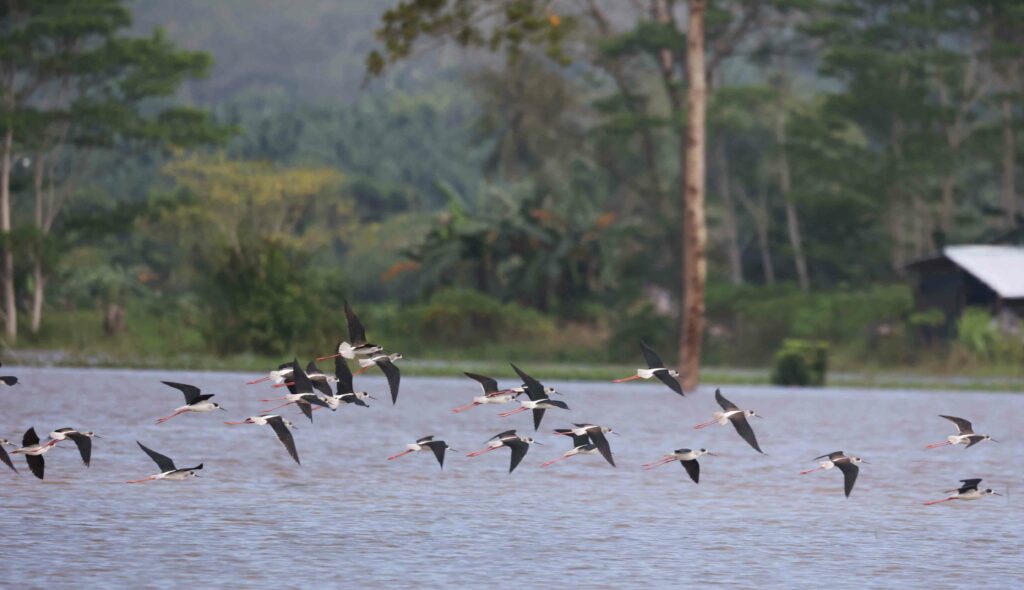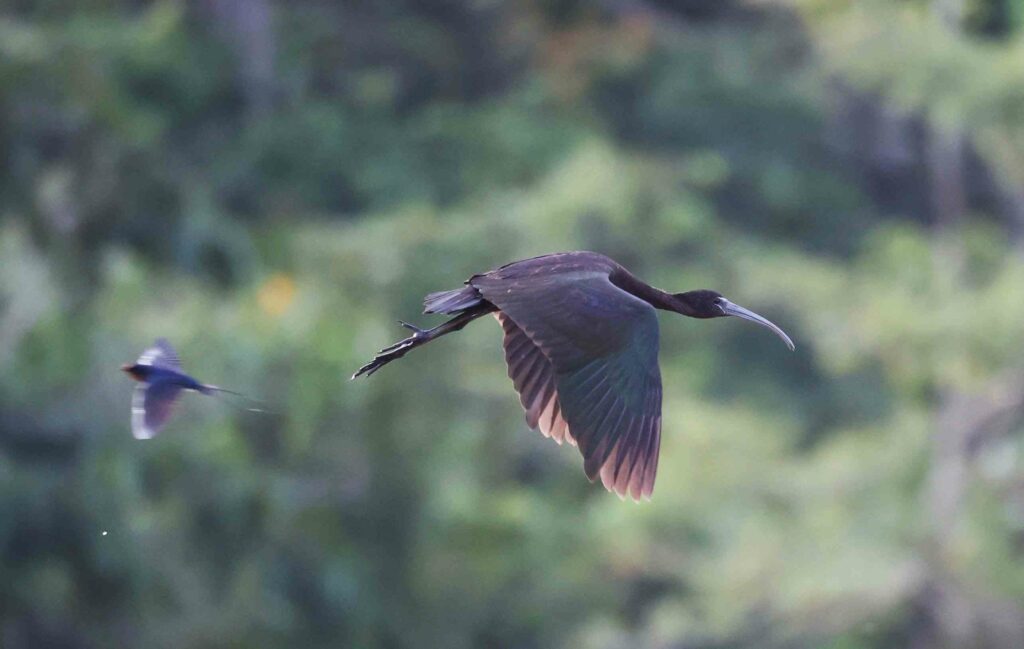
Waterbirds Around Us

Birds are a part of life and culture. Every morning, they sing beautiful melodies and glide around the sky as humans go about their daily routines. These winged creatures are all around. Sparrows play on the streets, egrets perch on cows, and seagulls swoop over the bay. There are many kinds of birds in a country where diverse sets of ecosystems exist. A prime example would be the Philippines, which is home to 743 avian species, of which around 60 species are waterbirds. Some of them are migratory birds that visit during the migration period, while some are endemic to the country.
Waterbirds are defined by the Ramsar Convention as birds that are ecologically dependent on wetlands. Different waterbirds are identified by their habitat: shorebirds and waders spend their time foraging for food on shores and mudflats; waterfowl families like ducks, geese, and swans have long necks and webbed feet to stay afloat on water; and seabirds thrive in marine environments. Waterbirds eat a variety of food found in or around water bodies. They also use different feeding techniques suitable for their body structures. Some use their beaks to sift aquatic life through their bills or peck on the ground for plant shoots and seeds. Other waterbirds dive right into the water to catch their meals.
These birds are all around. Waterbirds can be found in both freshwater and saltwater habitats, which is a common scenery in many countries. They mainly nest in wetlands, the open sea, and watercourses inside forests. Wetlands are areas covered or saturated with water. It includes rivers, lakes, reservoirs, ponds, freshwater swamps, mangroves, mudflats, coral reefs, and rice fields. A waterbird’s lifecycle is dependent on these habitats. They thrive in wetlands because these environments act as their food source, as well as their roosting and breeding sites. Thus, sighting birds near water is very common.
The Jetsetters of Bird Life

Some waterbirds are migratory, while some stay all year round in their homelands. Migratory waterbirds are those that travel regularly between their summer and winter grounds. Bird migration is a movement triggered by seasonal changes, variation in food supply, or genetic disposition. Not all migration patterns are the same. Some birds are taught flight patterns through generations, while some loners follow their instincts. Other flocks divide their journey into different stages, stopping in wetlands to replenish their energy. Migratory birds move from areas with low resources to areas with high resources. The primary goal in bird migration is finding food supply and nesting locations while moving across borders to ride out the winter season in their home country. That is the reason why they complete this cycle annually.
This phenomenon happens twice a year, involving millions of birds travelling across the world like clockwork. These birds have been observed to use the same route during their flight. They are able to do this by using visual landmarks, memorization, and celestial cues. Birds are also influenced by geomagnetism. They can sense and utilize the Earth’s magnetic field for navigation. This ability is called magnetoreception.
The consistent flight patterns of migratory birds form ‘flyways.’ Flyways are defined as the total area covered by birds in their annual cycle. It includes critical staging places like wetlands. Migratory birds rely on wetlands to sustain their long journeys. Wetlands provide shelter, food, and breeding ground for birds, becoming the haven and resting place of these winged voyagers before they continue their arduous journey. Migrating birds even stop at bodies of water in the middle of the desert to prepare themselves for their next flight. Some studies have seen the same birds on the same wetlands over the years. This is because the birds feel safe and familiar with these areas.
Migratory birds are not just plain visitors. Birds are dubbed as ‘ecosystem engineers’ due to their many roles in our planet. They contribute to the economy, ecology, and culture of a country. They help disperse seeds and act as natural pesticides for agriculture. The abundance of waterbirds also attracts ecotourism in wetland areas and presents opportunities for further scientific studies. The continuous attendance of migratory birds indicates the overall health of a country’s ecosystems. A large number of bird visitors annually means that the local wetlands are healthy and teeming with life. This spectacle boosts the attendance of birdwatchers who dedicate their passion to observing and protecting these migratory waterbirds.
But over the years, waterbirds have been facing growing threats due to the destruction of their habitats and urbanization. Wetlands are being drained and converted for other land uses, leaving the birds without a resting place. The lights of towering communication towers and skyscrapers attract birds, causing them to collide with infrastructure. This is also related to the significant number of casualties from wind farms, where birds get snagged in wind turbines or power lines. Bird strikes are also common when airplanes cross flyways or when airports are built near bird habitats.
Climate change also threatens bird habitats and migration due to the ecological shift leading to species re-distribution. The introduction of invasive species in their habitats also causes damage to bird population and could spread animal disease. Waterbirds that spend most of their time in the water are highly affected by oil spills and water pollution. Some birds mistake small plastic residues for food and consume them. Many plastic particles have been found on seabirds’ stomachs over the years.
Giving Winged Fowls Freedom to Live

The declining population of birds is the reason why we should rethink our development priorities. Sustaining their staging sites is crucial for the protection of these world travelers. The creation of bird-friendly cities and communities is essential to promote a green lifestyle while accommodating our feathered visitors.
Engineering a bird-friendly community includes welcoming nature back into our cities. It includes managing infrastructures, creating healthy habitats, and reducing pollution. This will involve the movement of citizens, the government, and businesses to help cities prosper while embracing nature around them.
The co-existence of humans and birds creates a harmonious relationship between humankind and the rest of life in the world. Promoting sustainable practices in our livelihoods and city planning will help both humans and birds thrive and co-benefit from each other. Embracing the crucial role of birds in our daily life breeds balance in a complex and diverse biosphere.
References:
- Arizona-Sonora Desert Museum. (2025). Water Birds. From: https://www.desertmuseum.org/books/nhsd_waterbirds_new.php
- Birds Carribean. (2025). CEBF 2025: Let’s Make Cities and Communities Bird-Friendly. From: https://www.birdscaribbean.org/2025/02/cebf-2025-lets-make-cities-and-communities-bird-friendly
- CornellLab. (2021). The Basics of Bird Migration: How, Why, and Where. From: https://www.allaboutbirds.org/news/the-basics-how-why-and-where-of-bird-migration/
- EAAFP. Migratory Waterbirds. From: https://eaaflyway.net/migratory-waterbirds/
- EAAFP. The Flyway. From: https://eaaflyway.net/the-flyway/
- Foote, S. (2023). Why we need to protect endangered waterbirds. UNEP. From: https://www.unep.org/news-and-stories/story/why-we-need-protect-endangered-waterbirds
- Hagemeijer, W. (2023). Where water meets land, life takes flight: Celebrating the beauty of wetlands and migratory birds. Weltrands International. From: https://www.wetlands.org/blog/wetlands-sustaining-bird-life
- Hore, P and Mackenzie, S. (2021). Magnetic sensitivity of cryptochrome 4 from a migratory songbird. From: https://www.nature.com/articles/s41586-021-03618-9
- Jensen, A.E. (2018). Internationally Important Waterbird Sites in Manila Bay, Philippines. Technical Report. Wetlands International and IUCN National Committee of the Netherlands.
- Keil, F. (2025). World Migratory Bird Day Unveils 2025 Conservation Theme: Creating Bird-Friendly Cities & Communities. Convention on the Conservation of Migratory Species of Wild Animals. From: https://www.cms.int/en/news/world-migratory-bird-day-unveils-2025-conservation-theme-creating-bird-friendly-cities
- Wetlands International. (2023). Wetlands – sustaining bird life. From: https://www.wetlands.org/blog/wetlands-sustaining-bird-life
- WWT. (2020). Migrations series: how birds use wetlands as migration service-stations. From: https://www.wwt.org.uk/news-and-stories/blog/migratory-service-stations-how-wetlands-help-birds-migrate
About the Author
Harriet Lois Villanueva is an environmental science student from the Philippine Women’s University and an intern at Wetlands International Philippines. Her interests align with the ocean, and she aims to dive more into marine conservation in the near future.
